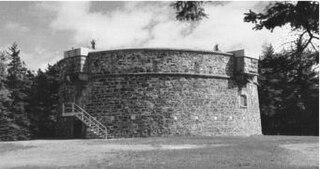
Martello towers, sometimes known simply as Martellos, are small defensive forts that were built across the British Empire during the 19th century, from the time of the French Revolutionary Wars onwards. Most were coastal forts.

Eastbourne Redoubt is a circular coastal defence fort at Eastbourne, East Sussex, on the south coast of England. It was built in 1805 as part of the British anti-invasion preparations during the Napoleonic Wars. Visitors to the Redoubt can now explore the fortress, discovering the stories of the people who lived there throughout its 200-year history.

Fort Grey, colloquially known as the "cup and saucer", is a Martello tower located on a tidal rock in Rocquaine Bay in Saint Peter, Guernsey on the west coast of the island.

Fort Denison, part of the Sydney Harbour National Park, is a protected national park that is a heritage-listed former penal site and defensive facility occupying a small island located north-east of the Royal Botanic Gardens and approximately 1 kilometre (0.62 mi) east of the Opera House in Sydney Harbour, New South Wales, Australia. The island was formerly known in its indigenous name of Mat-te-wan-ye, and as Pinchgut Island.
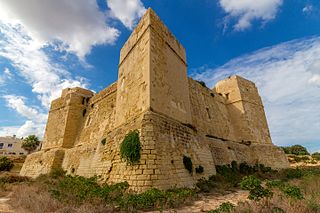
A watchtower is a type of fortification used in many parts of the world. It differs from a regular tower in that its primary use is military and from a turret in that it is usually a freestanding structure. Its main purpose is to provide a high, safe place from which a sentinel or guard may observe the surrounding area. In some cases, non-military towers, such as religious towers, may also be used as watchtowers.

Jaywick Martello Tower is a renovated Martello tower at Jaywick, 2.7 miles (4.3 km) south-west of Clacton-on-Sea, Essex. It now functions as an arts, heritage and community venue.
Jersey is a heavily fortified island with coastal fortifications that date from different periods such as the English Civil War, the Napoleonic Wars, and Nazi Germany's occupation of the Channel Islands. The fortifications include castles, forts, towers, Martello towers, artillery batteries, and seawalls. Not infrequently, fortifications from one period are built on the site of earlier fortifications, or very near them, geography having remained the same even when firepower increased.

Carleton Martello Tower in Saint John, New Brunswick, is one of the nine surviving Martello Towers in Canada. The tower dates from the War of 1812 and played a significant role in conflicts until the Second World War. The site now features a restored powder magazine, a restored barracks room, and exhibits in the tower and in the visitor centre. The tower's roof offers a view of the city of Saint John and its harbour. Carleton Martello Tower is one of the oldest buildings in the city and has been designated as a National Historic Site of Canada since 1930. It has been open to the public since 1963.
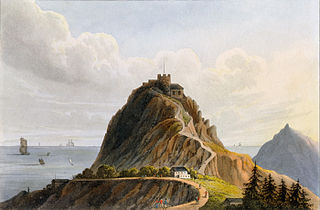
High Knoll Fort is a redoubt-style fort of the English East India Company on Saint Helena, an island and British overseas territory in the South Atlantic Ocean. High Knoll is 584 metres (1,916 ft) above sea level and is approximately one mile (1.6km) south of historic Lower Jamestown. Reopened on 18 December 2010, it is now a tourist attraction for visitors, especially those on the tourist ships that come in the summer.

Batterie Lothringen was a World War II coastal artillery battery in Saint Brélade, Jersey, named after the SMS Lothringen, and constructed by Organisation Todt for the Wehrmacht during the Occupation of the Channel Islands. The first installations were completed in 1941, around the same time as the completion of the nearby Battery Moltke, in St. Ouen.

The Bréhon Tower is accessible only by boat and sits on Bréhon rock, an island in the Little Russell channel about 1.5 km northeast of St Peter Port, Guernsey, between the port and the islands of Herm and Jethou. Thomas Charles de Putron (1806–1869) built the oval tower of granite from Herm, completing the work in 1857.

Fort Saumarez is a Martello tower in Saint Peter, Guernsey, on a headland that forms the northern tip of L'Erée and extends to the Lihou causeway.

Fort Hommet is a fortification on Vazon Bay headland in Castel, Guernsey. It is built on the site of fortifications that date back to 1680, and consists of a Martello tower from 1804, later additions during the Victorian Era, and bunkers and casemates that the Germans constructed during World War II.

The British built 15 Guernsey loophole towers at various points along the coast of Guernsey between August 1778 and March 1779 to deter possible French attacks after France had declared itself an ally of the American rebels in the American Revolutionary War. Towards the start of the Napoleonic Wars several towers received additional reinforcement in the form of batteries at their bases. Today, 12 towers still survive, three having been destroyed at different times. Two of the survivors, Petit Bôt and Rousse, contain interpretive exhibits that the public may examine.
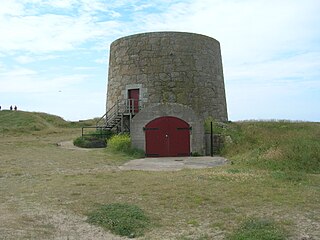
Lewis Tower, Jersey, is a Martello tower that the British erected in 1835 in St Ouen's Bay. The tower was named after Colonel Griffith George Lewis, who commanded the Royal Engineers in Jersey from December 1830 to January 1836.
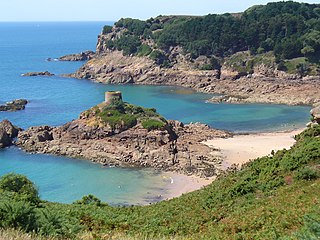
Portelet Tower, Jersey, is a Martello tower that the British built in 1808 on the tidal island L'Île au Guerdain in Portelet Bay in the parish of Saint Brélade, Jersey. The site is often referred to as Janvrin's tower or Janvrin's Tomb. The site is accessible at low tide.
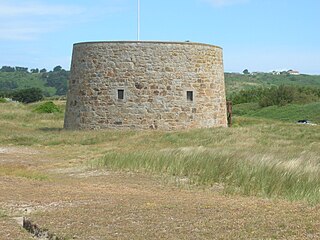
Kempt Tower, in La Grande Cueillette, Saint Ouen, Jersey, is also known as Saint Ouen No. 2 and La Grôsse Tou in Jèrriais, and is a Martello tower that the British completed in 1834. It is named for Sir James Kempt, the Master-General of the Ordnance from 1830 to 1834. While governor of Canada, Kempt was involved in the planning for the use of Martello towers to protect the colony. Currently, Kempt Tower serves as the interpretation centre for Les Mielles conservation area.

La Tour de Vinde,, is a Martello tower that the British erected between 1808 and 1810 to command the approaches to St Aubin's Bay, Jersey. The tower stands at the foot of the cliffs of Noirmont Point, in the Vingtaine de Noirmont in the Parish of Saint Brélade. During the occupation of the Channel Islands in World War II, the Germans erected Battery Lothringen on the top of Noirmont Point. The site of the tower is accessible at low tide by foot, though the tower itself is closed to the public.

The Martello Tower in Hambantota, is a small circular shaped fort, inspired by the Martello tower.

The island of Guernsey has been fortified for several thousand years, the number of defence locations and complexity of the defence increasing with time, manpower and the improvements in weapons and tactics.



















